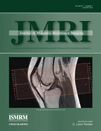Increased SNR and reduced distortions by averaging multiple gradient echo signals in 3D FLASH imaging of the human brain at 3T
Abstract
Purpose
To demonstrate how averaging of multiple gradient echoes can improve high-resolution FLASH (fast low angle shot) magnetic resonance imaging (MRI) of the human brain.
Materials and Methods
3D-FLASH with multiple bipolar echoes was studied by simulation and in three experiments on human brain at 3T. First, the repetition time (TR) was increased by the square of the flip angle to maintain contrast as derived by theory. Then the number of echoes was increased at constant TR with bandwidths between 110 and 1370 Hz/pixel. Finally, signals of a 12-echo acquisition train (echo times 4.9–59 msec) were averaged consecutively to study the increase in SNR.
Results
At unchanged contrast, the signal increased proportionally with flip angle and sqrt(TR). Increasing the bandwidth improved delineation of the basal cortex and vessels, while most of the loss in the signal-to-noise ratio (SNR) was recovered by averaging. Consecutive averaging increased the SNR to reach maximum efficiency at an echo train length corresponding roughly to T .
.
Conclusion
SNR is gained efficiently by acquiring additional echoes and increasing TR (and flip angle accordingly to maintain contrast) until the associated T loss in the averaged signal consumes the sqrt(TR) increase in the steady state. A bandwidth of 350 Hz/pixel or higher and echo trains shorter than T
loss in the averaged signal consumes the sqrt(TR) increase in the steady state. A bandwidth of 350 Hz/pixel or higher and echo trains shorter than T are recommended. J. Magn. Reson. Imaging 2009;29:198–204. © 2008 Wiley-Liss, Inc.
are recommended. J. Magn. Reson. Imaging 2009;29:198–204. © 2008 Wiley-Liss, Inc.




